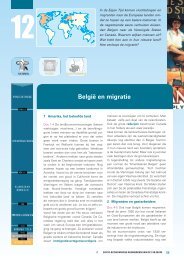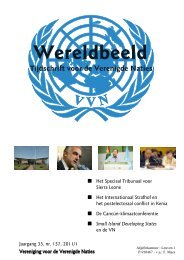Annex 5: United Nations Security Council Resolution 1874 (2009)
Annex 5: United Nations Security Council Resolution 1874 (2009)
Annex 5: United Nations Security Council Resolution 1874 (2009)
You also want an ePaper? Increase the reach of your titles
YUMPU automatically turns print PDFs into web optimized ePapers that Google loves.
According to most analysts, the Six Party Talks are probably the only mechanism that, if<br />
there was a desire by Pyongyang to reach a solution, could provide the means to solve it.<br />
However, the situation has deteriorated to the point now where the Six Party Talks have<br />
been rejected by the North. Also China may have a hard time getting the North Koreans back<br />
to the talks. Some observers are even stating that there first has to be a fundamental change<br />
in North Korea itself befor the Six Party Talks could resume again.<br />
As De Ceuster and Melissen write, progress in inter-Korean affairs also hinges on a peace<br />
treaty being signed to end formally the Korean War. Because there is an international<br />
dimension to the termination of the Korean War, agreement on a peace regime for the<br />
Korean Peninsula is also part of the Six-Party Talks. If and when the agenda of the Six-Party<br />
Talks is fully realized, the geopolitical map of North-East Asia will be fundamentally<br />
redrawn. The North Korean leadership is aware that for a small nation surrounded by big<br />
powers, a multilateral framework may be conducive to the protection of its interests. It is<br />
from this perspective that a continued US presence in the region is not opposed by North<br />
Korea’s Kim Jong-Il, who sees a regional role for the <strong>United</strong> States in maintaining Korea’s<br />
security (De Ceuster and Melissen, 2008).<br />
Situation on the ground: North Korea’s (presumed) assets<br />
The DPRK’s nuclear and WMD capabilities<br />
North Korea has conducted two nuclear weapon tests. On 9 October 2006, North Korea tested<br />
its first nuclear device at 10:35AM (local time) at Mount Mant’ap near P’unggye-ri, Kilchukun,<br />
North Hamgyong Province. The yield from this test appeared to be less than 1 kiloton;<br />
North Korea was reportedly expecting at least a 4 kiloton yield, possibly indicating that the<br />
North Korean nuclear program still had a number of technical hurdles to overcome before it<br />
had a usable warhead. In reaction to the test, the UN <strong>Security</strong> <strong>Council</strong> passed <strong>Resolution</strong><br />
1718 placing sanctions on North Korea. On 25 May <strong>2009</strong>, North Korea conducted its second<br />
nuclear test after having apparently warned the U.S. and Chinese government of their<br />
intentions. North Korea’s Korean Central News Agency announced that Pyongyang had<br />
carried out the nuclear test, and that it “was safely conducted on a new higher level in terms of its<br />
explosive power and technology of its control.” Initial estimates from the US government showed<br />
the test causing seismic activity equivalent to a magnitude of 4.7 on the Richter Scale and<br />
located close to the site of the first nuclear test in 2006. Early estimates pointed to a possible<br />
yield for the test of between 4 and 8 kilotons; while this is stronger than the first test, some<br />
analysts still questions the viability of Pyongyang’s nuclear warhead design (nti.org).<br />
So, what are the nuclear capabilities of North Korea? According to Larry A Niksch, most of North<br />
Korea’s plutonium-based nuclear installations are located at Yongbyon, 60 miles from the<br />
North Korean capital of Pyongyang. The key installations are as follows (Niksch, <strong>2009</strong>):<br />
- An atomic reactor, with a capacity of about 5 electrical megawatts that began operating by<br />
1987. It is capable of expending enough reactor fuel to produce about 6 kilograms of<br />
plutonium annually—enough for the manufacture of a single atomic bomb annually.<br />
As of late 2008, North Korea had completed eight of the eleven steps of the<br />
disablement of the reactor, including the removal of equipment from the reactor and<br />
the blowing up of reactor’s cooling tower.<br />
- Two larger (estimated 50 megawatts and 200 electrical megawatts) reactors under<br />
construction at Yongbyon and Taechon since 1984.<br />
© <strong>2009</strong> – Dr. D. Criekemans – Negotiations in UNSC on the continuing security provocations by North Korea 14







